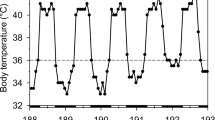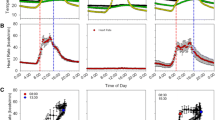Abstract
Behavioral and physiological adaptations are common and successful strategies used by small endothermic species to adjust to unfavorable seasons. Physiological adaptations, such as heterothermy, e.g., torpor, are usually thought to be more effective energy-saving strategies than behavioral adjustments. The African lesser bushbaby, Galago moholi, is physiologically capable of torpor but expresses heterothermy only under conditions of extreme energy limitation, suggesting that it has evolved alternative strategies to compensate energetic bottlenecks. We hypothesized that Galago moholi survives the unfavorable winter period, without —or only rarely— employing torpid phases to save energy, by using behavioral thermoregulation. We compared the ecology and behavior of Galago moholi in summer and winter by telemetric tracking and examined food availability by determination of arthropod and gum availability. We found a significant increase in huddling behavior and a significant increase in the use of enclosed and insulated sleeping sites during winter, as well as a reduction in nightly activity. Galago moholi hunted for insects significantly less in winter than in summer, and increased gum intake in winter, when gum showed an increase in energy content. The availability of high-quality food, albeit in low quantities, presumably enables Galago moholi to stay normothermic throughout the cold, dry period and to focus on reproduction activities. We propose that Galago moholi favors ecological and behavioral adjustments over torpor because these are sufficient to meet energy requirements of this species, and their advantages (flexibility, unrestricted activity, and reproduction) outweigh the energetic benefits of heterothermy.



Similar content being viewed by others
References
Bearder, S., & Martin, R. (1980). Acacia gum and its use by bushbabies, Galago senegalensis (Primates: Lorisidae). International Journal of Primatology, 1(2), 103–128.
Black, H. L. (1974). A north temperate bat community: structure and prey populations. Journal of Mammalogy, 55(1), 138–157.
Boix-Hinzen, C., & Lovegrove, B. G. (1998). Circadian metabolic and thermoregulatory patterns of red-billed woodhoopoes (Phoeniculus purpureus): the influence of huddling. Journal of Zoology, 244(1), 33–41.
Churchill, S. K. (1994). Diet, prey selection and foraging behaviour of the orange horseshoe-bat, Rhinonycteris aurantius. Wildlife Research, 21(2), 115–130.
Dammhahn, M., & Kappeler, P. (2008). Comparative feeding ecology of sympatric Microcebus berthae and M. murinus. International Journal of Primatology, 29(6), 1567–1589.
Dasilva, G. L. (1993). Postural changes and behavioural thermoregulation in Colobus polykomos: the effect of climate and diet. African Journal of Ecology, 31(3), 226–241.
Dausmann, K. H. (2008). Hypometabolism in primates: torpor and hibernation. In B. G. Lovegrove & A. E. McKechnie (Eds.), Hypometabolism in animals: hibernation, torpor and cryobiology (pp. 327–336). Pietermaritzburg: Interpak.
Dausmann, K. H., Nowack, J., Kobbe, S., & Mzilikazi, N. (2012). Afrotropical heterothermy: a continuum of possibilities. In T. Ruf, C. Bieber, W. Arnold, & E. Millesi (Eds.), Living in a seasonal world: thermoregulatory and metabolic adaptations: 14th Hibernation Symposium (pp.13-27). Heidelberg: Springer.
Donati, G., Ricci, E., Baldi, N., Morelli, V., & Borgognini-Tarli, S. M. (2011). Behavioral thermoregulation in a gregarious lemur, Eulemur collaris: effects of climatic and dietary-related factors. American Journal of Physical Anthropology, 144(3), 355–364.
Entwistle, A. C., Racey, P. A., & Speakman, J. R. (1997). Roost selection by the brown long-eared bat Plecotus auritus. Journal of Applied Ecology, 34(2), 399–408.
Furuichi, T., Hashimoto, C., & Tashiro, Y. (2001). Extended application of a marked-nest census method to examine seasonal changes in habitat use by chimpanzees. International Journal of Primatology, 22(6), 913–928.
Geiser, F. (2004a). Metabolic rate and body temperature reduction during hibernation and daily torpor. Annual Review of Physiology, 66, 239–274.
Geiser, F. (2004b). The role of torpor in the life of Australian arid zone mammals. Australian Mammalogy, 26, 125–134.
Génin, F., Masters, J. C., & Ganzhorn, J. U. (2010). Gummivory in Cheirogaleids: primitive retention or adaptation to hypervariable environments? In A. M. Burrows & L. T. Nash (Eds.), The evolution of exudativory in primates (pp. 123–140). New York: Springer.
Genoud, M., Martin, R. D., & Glaser, D. (1997). Rate of metabolism in the smallest simian primate, the pygmy marmoset (Cebuella pygmaea). American Journal of Primatology, 41(3), 229–245.
Gilbert, C., McCafferty, D., Le Maho, Y., Martrette, J., Giroud, S., Blanc, S., & Ancel, A. (2010). One for all and all for one: the energetic benefits of huddling in endotherms. Biological Reviews, 85(3), 545–569.
Harcourt, C. (1986). Seasonal variation in the diet of south african galagos. International Journal of Primatology, 7(5), 491–506.
Harcourt, C. S., & Bearder, S. K. (1989). A comparison of Galago moholi in South Africa with Galago zanzibaricus in Kenya. International Journal of Primatology, 10(1), 35–45.
Harris, T. R., Chapman, C. A., & Monfort, S. L. (2010). Small folivorous primate groups exhibit behavioral and physiological effects of food scarcity. Behavioral Ecology, 21(1), 46–56.
Heldmaier, G., Ortmann, S., & Elvert, R. (2004). Natural hypometabolism during hibernation and daily torpor in mammals. Respiratory Physiology & Neurobiology, 141, 317–329.
Hill, R. A., & Dunbar, R. I. M. (2002). Climatic determinants of diet and foraging behaviour in baboons. Evolutionary Ecology, 16(6), 579–593.
Hladik, C. M., Charles-Dominique, P., & Petter, J. J. (1980). Feeding strategies of five nocturnal prosimians in the dry forest of the west coast of Madagascar. In P. Charles-Dominique, H. M. Cooper, A. Hladik, C. M. Hladik, E. Pages, G. F. Pariente, A. Petter-Rousseaux, J. J. Petter & A. Schilling et al. (Eds.), Nocturnal Malagasy primates: ecology, physiology, and behavior (pp. 41–73). New York: Academic Press.
Humphries, M. M., Kramer, D. L., & Thomas, D. W. (2003). The role of energy availability in mammalian hibernation: an experimental test in free-ranging eastern chipmunks. Physiological and Biochemical Zoology, 76(2), 180–186.
Joly-Radko, M., & Zimmermann, E. (2010). Seasonality in gum and honeydew feeding in grey mouse lemurs. In A. M. Burrows & L. T. Nash (Eds.), The evolution of exudativory in primates (pp. 141–153). New York: Springer.
Kates, M. (1972). Technology of lipidology. In T. S. Work & E. Work (Eds.), Laboratory techniques in biochemistry and molecular biology (pp. 267–610). Amsterdam: North Holland.
Kotze, D. J., & Samways, M. J. (1999). Invertebrate conservation at the interface between the grassland matrix and natural Afromontane forest fragments. Biodiversity and Conservation, 8(10), 1339–1363.
Lovegrove, B. G., Heldmaier, G., & Knight, M. (1991). Seasonal and circadian energetic patterns in an arboreal rodent, Thallomys paedulcus, and a burrow-dwelling rodent, Aethomys namaquensis, from the Kalahari Desert. Journal of Thermal Biology, 16(4), 199–209.
McKechnie, A. E., & Mzilikazi, N. (2011). Heterothermy in Afrotropical mammals and birds: a review. Integrative and Comparative Biology, 51(3), 349–363.
Morland, H. S. (1993). Seasonal behavioural variation and its relationship to thermoregulation in ruffed lemurs (Varecia variegata variegata). In P. M. Kappeler & J. U. Ganzhorn (Eds.), Lemur social systems and their ecological basis. New York: Plenum.
Mzilikazi, N., & Lovegrove, B. G. (2004). Daily torpor in free-ranging rock elephant shrews, Elephantulus myurus: a year-long study. Physiological and Biochemical Zoology, 77(2), 285–296.
Nash, L. T. (1986). Dietary, behavioral, and morphological aspects of gummivory in primates. American Journal of Physical Anthropology, 29(S7), 113–137.
Nowack, J., Mzilikazi, N., & Dausmann, K. H. (2010). Torpor on demand: heterothermy in the non-lemur primate Galago moholi. PLoS ONE, 5(5). doi:10.1371/journal.pone.0010797
Øritsland, N. A. (1970). Temperature regulation of the polar bear (Thalarctos maritimus). Comparative Biochemistry and Physiology, 37(2), 225–233.
Ostner, J. (2002). Social thermoregulation in redfronted lemurs (Eulemur fulvus rufus). Folia Primatologica, 73(4), 175–180.
Pavey, C., Burwell, C., Körtner, G., & Geiser, F. (2009). Vertebrate diet decreases winter torpor use in a desert marsupial. Naturwissenschaften, 96(6), 679–683.
Perret, M. (1998). Energetic advantage of nest-sharing in a solitary primate, the lesser mouse lemur (Microcebus murinus). Journal of Mammalogy, 79(4), 1093–1102.
Power, M. L. (2010). Nutritional and digestive challenges to being a gum-feeding primate. In A. M. Burrows & L. T. Nash (Eds.), The evolution of exudativory in primates (pp. 25–44, Developments in Primatology: Progress and Prospects). New York: Springer.
Pullen, S. L., Bearder, S. K., & Dixson, A. F. (2000). Preliminary observations on sexual behavior and the mating system in free-ranging lesser galagos (Galago moholi). American Journal of Primatology, 51, 79–88.
Scantlebury, M., Bennett, N. C., Speakman, J. R., Pillay, N., & Schradin, C. (2006). Huddling in groups leads to daily energy savings in free-living African four-striped grass mice, Rhabdomys pumilio. Functional Ecology, 20(1), 166–173.
Schülke, O. (2003). To breed or not to breed—food competition and other factors involved in female breeding decisions in the pair-living nocturnal fork-marked lemur (Phaner furcifer). Behavioral Ecology and Sociobiology, 55(1), 11–21.
Taylor, R., & O’Neill, M. (1988). Summer activity patterns of insectivorous bats and their prey in Tasmania. Wildlife Research, 15(5), 533–539.
Acknowledgments
The study was conducted at Nylsvley Nature Reserve. We thank the Limpopo Province Department of Agriculture and Environment for their hospitality and permission to work at Nylsvley Nature Reserve. Nangamso Thole, Lebogang Johanna Selomo, and Lucas Mamanyane provided invaluable assistance in the field. We thank J. Ganzhorn for his continuous scientific support. We also thank two anonymous reviewers for their helpful comments on an earlier draft of the manuscript. Financial support was received from the Deutscher Akademischer Austauschdienst and the Deutsche Forschungsgemeinschaft (DA 1031/3-1/2).
Author information
Authors and Affiliations
Corresponding author
Rights and permissions
About this article
Cite this article
Nowack, J., Wippich, M., Mzilikazi, N. et al. Surviving the Cold, Dry Period in Africa: Behavioral Adjustments as an Alternative to Heterothermy in the African Lesser Bushbaby (Galago moholi). Int J Primatol 34, 49–64 (2013). https://doi.org/10.1007/s10764-012-9646-8
Received:
Accepted:
Published:
Issue Date:
DOI: https://doi.org/10.1007/s10764-012-9646-8




